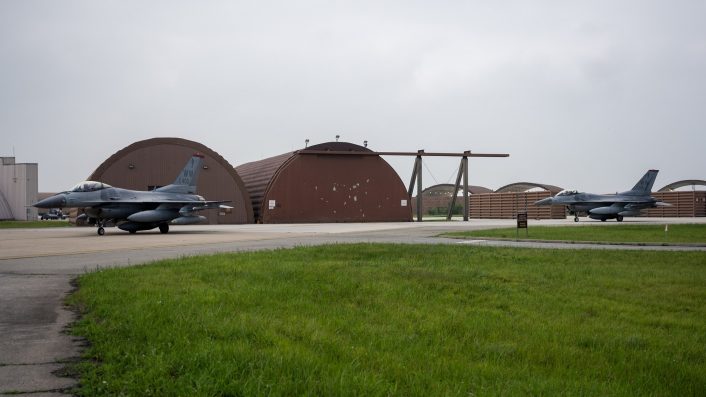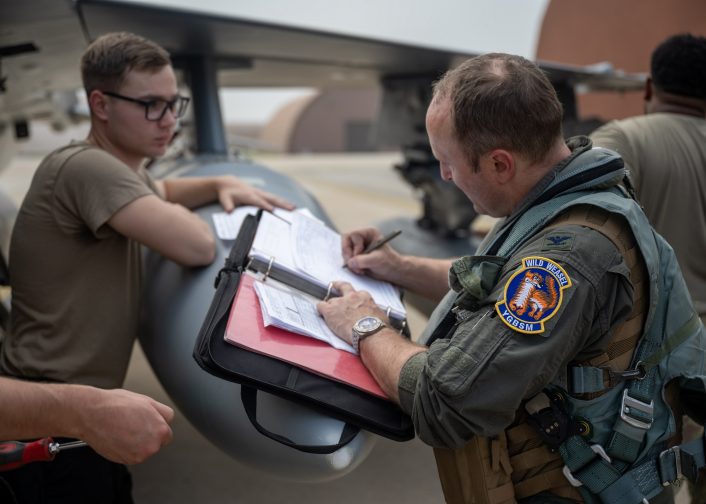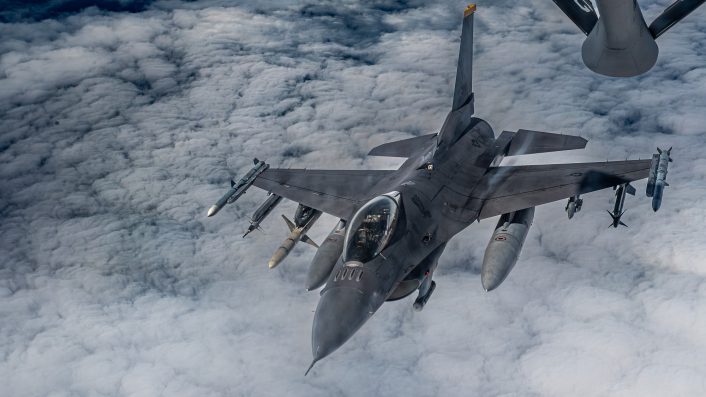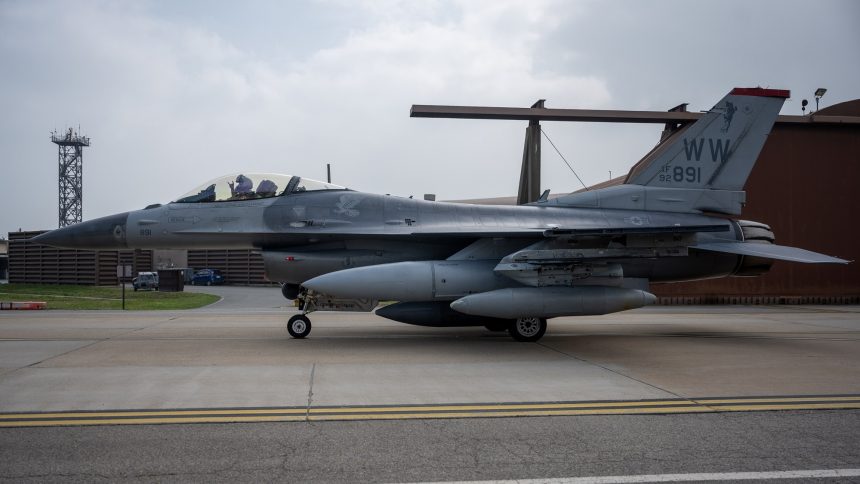The arrival of the F-16s marked a significant step forward in modernizing the 51st Fighter Wing aircraft and strengthening the U.S. Air Force’s regional combat readiness.
The 51st Fighter Wing at Osan Air Base, South Korea, recently received upgraded F-16 Fighting Falcons transferred from the 35th Fighter Wing at Misawa Air Base, Japan. The arrival of the F-16s on June 26-27, 2025, “marked a significant step forward in modernizing the 51st Fighter Wing aircraft and strengthening the U.S. Air Force’s regional combat readiness,” said the U.S. Air Force in a press release.
The service explained that “the F-16s received a series of avionics system upgrades, bringing them closer to fifth-generation capabilities.” This is a reference to the aircraft being upgraded through the Post Block Integration Team (PoBIT) project, which aims to have Block 40 and Block 50 aircraft, the so-called “Post Block” F-16s, fly well into the 2040s.
These enhancements improve both survivability and combat effectiveness accuracy of the weapon system, added the press release. In fact, F-16s upgraded trough PoBIT have new radar, computers and electronic warfare systems.
“F-16s are one of the only multi-role fighters,” said U.S. Air Force Capt. Alexandra Sears, 25th Fighter Generation Squadron director of operations. “They can do everything. They’re incredibly lightweight and quick, and when you upgrade the F-16s, they’re able to do so many missions, such as providing close air support like the A-10 or suppressing enemy air defense missions.”

Modernization at Osan
Osan Air Base is one of two major U.S. Air Force installations in South Korea, the other being Kunsan Air Base. The base is approximately 40 miles south of Seoul, the capital city of South Korea, and 48 miles south of the Korean Demilitarized Zone (DMZ).
The base is currently at the center of the U.S. Air Force’s modernization strategy in the country, following a modernization plan announced by the Department of Defense on July 3, 2024. The service mentioned the new strategy bolsters deterrence against North Korea and reaffirms the ironclad U.S. security commitment to the South Korea-U.S. alliance by strengthening South Korean and U.S. combined defense.
Starting in January 2025, the 25th Fighter Squadron at Osan Air Base started a phased withdrawal of its 24 A-10 aircraft, with completion expected by the end of fiscal year 2025. Multiple ferry flights of A-10s have been recently reported online by flight trackers.
On the other hand, the 25th FS sister unit, the 36th FS, is currently part of what initially was a year-long test to optimize combat capability and training effectiveness with a larger number of F-16 aircraft assigned to the “Super Squadron”. The unit received in 2024 nine F-16s from Kunsan Air Base, bringing the total of its aircraft from 22 to 31 F-16s.
In April 2025, the Seventh Air Force, which oversees U.S. air operations in Korea and in the Northwest Pacific, has received the approval to extend the “Super Squadron” test for a second phase. This new phase, which will build on the results of the data analyzed during the ongoing first phase, will begin in October 2025 and will see 31 additional F-16s and approximately 1,000 Airmen move to Osan AB from Kunsan AB to establish the second squadron.

Misawa’s F-16s
In December 2024, it was revealed that the 35th Fighter Wing at Misawa Air Base, Japan, would receive the first F-35 in 2026. This followed the earlier announcement in July 2024 that Misawa would replace its F-16CM Block 50 with new F-35As as part of the ongoing modernization.
It now appears that some of the F-16s are now being transferred to Osan and will continue to fly alongside the base’s Block 40s. The photos show at least two F-16s assigned to the 13th Fighter Squadron arriving at Osan, piloted by Col. Paul Davidson, 35th Fighter Wing commander, and Col. Matt Kenkel, 35th Fighter Wing deputy commander, who also signed transfer documents once at destination.
“At Osan, the upgraded F-16s bring unparalleled multi-role versatility and superior operational range,” says the Air Force. “These capabilities directly support the 51st Fighter Wing’s ability to ensure peace and stability on the Korean Peninsula.”
Given the close proximity to the DMZ, the service explained that, “as the U.S. Air Force’s most forward deployed, permanently-based wing, the 51st FW plays a critical role in maintaining regional security.” The “new” aircraft will give the units increased capabilities without having to wait for a lengthy conversion to another aircraft.
“These upgrades enhance our game a bit,” said Chief Master Sgt. Robert Parsons, 25th FGS senior enlisted leader. “The F-16’s new features give pilots greater spatial awareness, helping them see the battlefield more clearly. As we move closer to 2027, having a capable aircraft now, instead of waiting for a new airframe, is critical. The F-16 already has an established support system in place for supply, personnel, equipment, and training. With these upgrades, we now have the aircraft we need, ready and available today.”
We reached out to the U.S. Air Force for further details and Maj. Kip Sumner, a spokesperson for the 51st FW, confirmed that these F-16s are being permanently transferred to the 51st Fighter Wing at Osan Air Base, as part of a continuous effort to modernize U.S. airpower and defensive capabilities on the Korean Peninsula.
The squadron to which the F-16s will be assigned has not been explicitly stated in the press release, although there are multiple mentions of the 25th FGS and statements from the unit’s personnel. We thus inquired about the possibility of the aircraft being assigned to the 25th Fighter Squadron to replace the A-10Cs.
“At this time, we are not disclosing the detailed movement or assignment of assets outside of what has been previously published,” told us Maj. Sumner regarding the unit which will employ the aircraft. “These aircraft will be a part of the 51st Fighter Wing inventory here at Osan Air Base.”
Regarding the mentions of the 25th FGS, Maj. Sumner further told us that “as part of the phased withdrawal of our A-10s from Korea, which started in Jan 2025, some of our A-10 personnel will be trained to support the increased number of F-16s at Osan. Receiving aircraft like this provides valuable training for our personnel as they transition to a new platform or prepare for a future assignment.”

Upgraded Vipers in Korea
The 8th FW at Kunsan Air Base received in 2023 its first upgraded F-16, as the aircraft is expected to fly well into the 2040s. A total of 608 Block 40 and Block 50 aircraft, the so-called “Post Block” F-16s, will be upgraded through the Post Block Integration Team (PoBIT) project managed by the Air Force Life Cycle Management Center’s Fighters and Advanced Aircraft Directorate.
The project includes up to 22 modifications designed to improve lethality and ensure the fourth-generation fighter remains effective in meeting current and future threats. Launched in 2022, the PoBIT upgrades are being performed in conjunction with the Service Life Extension Program (SLEP) which will extend the airframes’ fatigue life from 8,000 to 12,000 hours.
The SLEP will replace structural bulkheads and longerons, modify wing and wing-box assemblies, install new structural brackets and beam supports and reskin the upper fuselage. The depot work for the entire process takes up to nine months for each Viper and is being performed at multiple locations both in the United States and in Europe.
The main feature of the PoBIT upgrade is the installation of the APG-83 Scalable Agile Beam Radar (SABR) with Active Electronically Scanned Array and the Center Display Unit (CDU), technology that ultimately gives the F-16 and its pilot a clearer vision of the threat picture to increase both the survivability and accuracy of the weapon system. The updated F-16 radar systems allow pilots to use Synthetic Aperture Radar mapping to detect and deploy weapons against air-to-air and air-to-ground threats at much longer ranges.

The CDU replaces the instruments located on the center pedestal with a 6 by 8 inches multi-function high resolution color display and allows not only to take full advantage of the new radar and upgraded targeting pods, but also to reduce the pilot’s workload and increase safety and efficiency. As part of PoBIT, the Northrop Grumman AN/ALQ-257 Integrated Viper Electronic Warfare Suite is replacing the legacy electronic warfare systems, providing a next generation EW system that is internal to the F-16 and fully interoperable with the new on-board APG-83 radar.
Other upgrades include Link 16, modernizing the cockpit and main mission computer, and converting the fleet to a high-speed data network, as well as next-generation electronic warfare capability, a Communication Suite Upgrade, a Programmable Data Generator and several other key hardware components. PoBIT upgrades for the F-16 fleet are being conducted in various phases to provide the aircraft the necessary updates while ensuring operational requirements can still be met.
The article has been updated with the statements provided by the 51st Fighter Wing.









